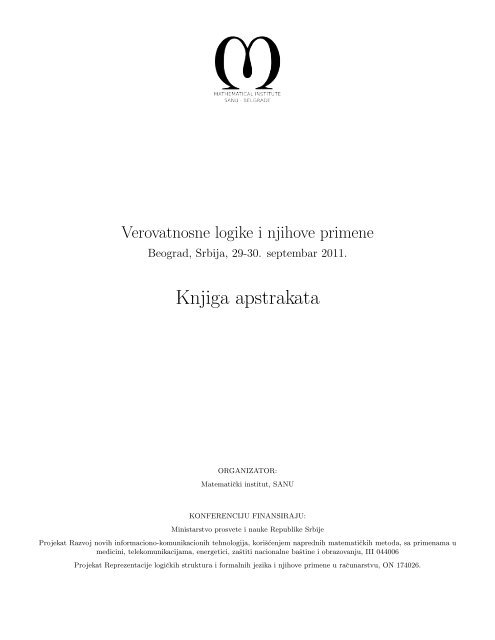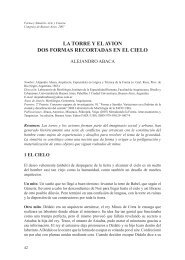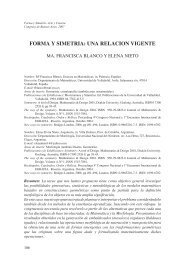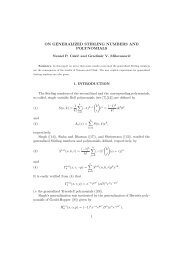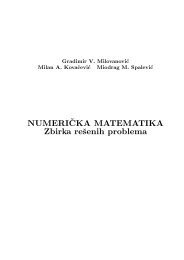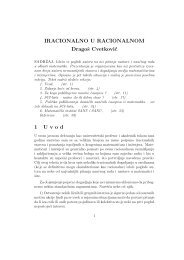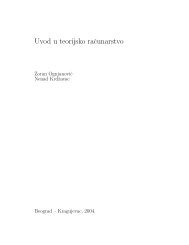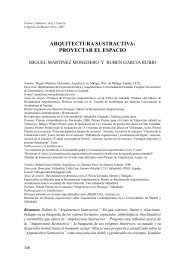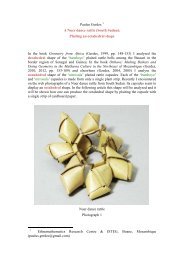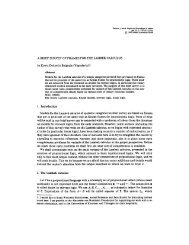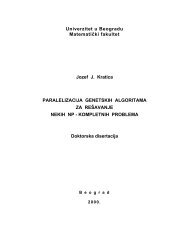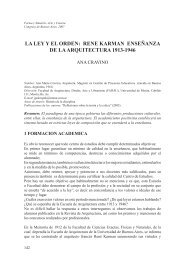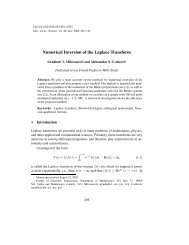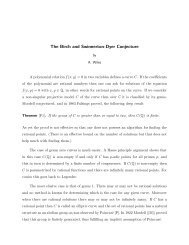Knjiga apstrakata - Mathematical Institute of the Serbian Academy of ...
Knjiga apstrakata - Mathematical Institute of the Serbian Academy of ...
Knjiga apstrakata - Mathematical Institute of the Serbian Academy of ...
Create successful ePaper yourself
Turn your PDF publications into a flip-book with our unique Google optimized e-Paper software.
Verovatnosne logike i njihove primeneBeograd, Srbija, 29-30. septembar 2011.<strong>Knjiga</strong> <strong>apstrakata</strong>ORGANIZATOR:Matematički institut, SANUKONFERENCIJU FINANSIRAJU:Ministarstvo prosvete i nauke Republike SrbijeProjekat Razvoj novih informaciono-komunikacionih tehnologija, korišćenjem naprednih matematičkih metoda, sa primenama umedicini, telekomunikacijama, energetici, zaštiti nacionalne baštine i obrazovanju, III 044006Projekat Reprezentacije logičkih struktura i formalnih jezika i njihove primene u računarstvu, ON 174026.
Verovatnosne logike i njihove primeneBeograd, Srbija, 29-30. septembar 2011.TEME KONFERENCIJE:- verovatnosne logike, problemi potpunosti, odlučivosti i složenosti,- logičke osnove u zasnivanju verovatnoće,- Bayes-ove mrrže i drugi srodni sistemi,- programski sistemi za podršku odlučivanju u prisustvu neizvesnosti,- primene verovatnosnog zaključivanja u medicini itd.PROGRAMSKI KOMITET:Miodrag Rašković; (Matematički institut SANU), predsednikZoran Marković (Matematički institut SANU)Zoran Ognjanović (Matematički institut SANU)Nebojša Ikodinović (Univerzitet u Beogradu)Aleksandar Perović (Univerzitet u Beogradu)ORGANIZACIONI KOMITET:Miodrag Rašković; (Matematički institut SANU)Ivan Čukić; (Matematički institut SANU)ORGANIZATOR:Matematički institut, SANUKONFERENCIJU FINANSIRAJU:Ministarstvo prosvete i nauke Republike SrbijeProjekat Razvoj novih informaciono-komunikacionih tehnologija, korišćenjem naprednih matematičkih metoda, sa primenama umedicini, telekomunikacijama, energetici, zaštiti nacionalne baštine i obrazovanju, III 044006Projekat Reprezentacije logičkih struktura i formalnih jezika i njihove primene u računarstvu, ON 174026.
Program konferencije:Dan 1 - 29. 9. 2011.Sesija 1 Predsedava Miomir Stanković10:00 – 10:15 Otvaranje10:20 – 11:20 Zvonimir Šikić: Bayesian probability <strong>the</strong>ory is <strong>the</strong> probability logic11:20 – 12:20 Daniel Romano: Constructive Anti-ideals Theory <strong>of</strong> Commutative Rings12:20 – 13:20 Siniša Crvenković: Konstruktivne polugrupe13:20 – 15:00 PauzaSesija 2 Predsedava Zoran Marković15:00 – 15:20 Dragan G. Radojević: Fazi verovatnoće u Bulovom okviru15:25 – 15:45 Velimir M. Ilić, Miomir S. Stanković, Branimir T. Todorović: Message Passing Algorithms over <strong>the</strong>Binomial and <strong>the</strong> Entropy Semirings15:50 – 16:10 Nebojša Ikodinović, Miodrag Rašković, Zoran Marković, Zoran Ognjanović: A first-order probabilisticlogic with approximate conditional probabilities16:15 – 16:35 Angelina Ilić Stepić, Zoran Ognjanović, Nebojša Ikodinović, and Aleksandar Perović: A p-adicprobability logic16:40 – 17:00 PauzaSesija 3 Predsedava Zvonimir Sikić17:00 – 17:20 Vladimir Ristić, Radosav Djordjević, Nebojša Ikodinović: Biprobability logic with conditional expectation17:25 – 17:45 Ivan Živković, Miomir Stanković: Artificial Neural Networks for Decision Support in copper smeltingprocess17:50 – 18:10 Edin H. Mulalić, Miomir S. Stanković: Functional Decomposition as an Optimization TechniqueDan 2 - 30. 9. 2011.Sesija 1 Predsedava Danijel Romano10:00 – 10:20 Nataša Glišović: Analiza DNK mesavine koriscenjem Bjesovih mreza10:25 – 10:45 Ivan Čukić: An optimised index structure for static deductional databases based on fuzzy or probabilisticDLs10:50 – 11:10 Tatjana Stojanović: Probability description language P-ALCN11:15 – 11:35 Marina Svičević: Primena Bajesovih mreža u medicinskoj dijagnostici11:35 – 12:10 PauzaSesija 2 Predsedava Siniša Crvenković12:10 – 12:30 Nataša Glišović, Milan Božić: The System for Random Man not Excluded12:35 – 12:55 Saša Rašuo: Monadic Calculus and Constituents13:00 – 13:20 Dragan Doder, Zoran Marković, Zoran Ognjanović: A Branching-time Probabilistic Logic13:25 – 13:45 Jasmina Fijuljanin, Aleksandar Kartelj, Jelena Kojić: Electromagnetism metaheuristic for probabilisticsatisfiability problem13:45 – 14:00 PauzaSesija 3 Predsedava Dragan Radojević14:00 – 14:20 Petar Maksimović: Formal Verification <strong>of</strong> Key Properties for Several Probability Logics in <strong>the</strong> Pro<strong>of</strong>Assistant Coq14:25 – 14:45 Aleksandar Perović: On Archimedean inference rule14:50 – 15:10 Djordje Djordjević, Srbislav Nešić: Pseudo-Random Number Generator Using as a Seed Distance(Movement) <strong>of</strong> a Laboratory Cultured Daphniae15:15 – 15:35 Miloš Laban: A solution <strong>of</strong> <strong>the</strong> gambling paradox using <strong>the</strong> principle <strong>of</strong> dimensionality15:40 – 16:00 Vladimir Srdanović: Sistem za podršku u kliničkom odlučivanju koji integriše znanje Eksperta iznanje iz podataka
Apstrakti
SadržajA Branching-time Probabilistic Logic 11Dragan Doder, Zoran Marković, Zoran OgnjanovićA first-order probabilistic logic with approximate conditional probabilities 13Nebojša Ikodinović, Miodrag Rašković, Zoran Marković and Zoran OgnjanovićA p-adic probability logic 14Angelina Ilić Stepić, Zoran Ognjanović, Nebojša Ikodinović, and Aleksandar PerovićAn optimised index structure for static deductional databases based on fuzzy or probabilisticDLs 15Ivan ČukićAnaliza DNK mesavine koriscenjem Bjesovih mreza 16Nataša GlišovićArtificial Neural Networks for Decision Support in copper smelting process 17Ivan Živković and Miomir StankovićBayesian probability <strong>the</strong>ory is <strong>the</strong> probability logic 19Zvonimir Šikić, ZagrebBiprobability logic with conditional expectation 20Vladimir Ristić, Radosav Djordjević, Nebojša IkodinovićConstructive Anti-ideals Theory <strong>of</strong> Commutative Rings 21Daniel RomanoElectromagnetism metaheuristic for probabilistic satisfiability problem 22Jasmina Fijuljanin, Aleksandar Kartelj and Jelena KojićFazi verovatnoće u Bulovom okviru 24Dragan G. RadojevićFormal Verification <strong>of</strong> Key Properties for Several Probability Logics in <strong>the</strong> Pro<strong>of</strong> AssistantCoq 25Petar MaksimovićFunctional Decomposition as an Optimization Technique 26Edin H. Mulalić, Miomir S. StankovićKonstruktivne polugrupe 28Siniša CrvenkovićMessage Passing Algorithmsover <strong>the</strong> Binomial and <strong>the</strong> Entropy Semirings 29Velimir M. Ilić, Miomir S. Stanković and Branimir T. Todorović9
Monadic Calculus and Constituents 31Saša RasuoOn Archimedean inference rule 32Aleksandar PerovićPrimena Bajesovih mreža u medicinskoj dijagnostici 33Svičević MarinaProbability description language P − ALCN 34Tatjana StojanovićPseudo-Random Number Generator Using as a Seed Distance (Movement) <strong>of</strong> a LaboratoryCultured Daphniae 35Djordje Djordjević and Srbislav NešićThe System for Random Man not Excluded 36Nataša Glišović, Milan BožićA solution <strong>of</strong> <strong>the</strong> “gambling paradox” using <strong>the</strong> principle <strong>of</strong> dimensionality 38Miloš LabanSistem za podršku u kliničkom odlučivanju koji integriše znanje eksperta i znanje izpodataka 39Vladimir Srdanović10
A Branching-time Probabilistic LogicDragan Doder Zoran Marković Zoran OgnjanovićInterest in temporal reasoning came from <strong>the</strong>oretical and practical points <strong>of</strong> view. Logicians [3, 4, 17] investigatedconsequences <strong>of</strong> different assumptions about <strong>the</strong> structure <strong>of</strong> time, while temporal formalisms can be used in computerscience to reason about properties <strong>of</strong> programs [8, 6]. In both cases discrete linear and branching time logics have beenextensively studied. Linear temporal logics are suitable for specification and verification <strong>of</strong> universal properties <strong>of</strong> allexecutions <strong>of</strong> programs. On <strong>the</strong> o<strong>the</strong>r hand, <strong>the</strong> branching time approach is appropriate to analyze nondeterministiccomputations described in <strong>the</strong> form <strong>of</strong> execution trees. In <strong>the</strong> later framework a state (a node) may have many successors.Then, it is natural to attach probabilities to <strong>the</strong> corresponding transitions and to analyze <strong>the</strong> corresponding discrete timeMarkov chains as <strong>the</strong> underlying structures. All this led to probabilistic branching temporal logic [1, 2, 9].In this paper we introduced a propositional discrete probabilistic branching temporal logic (denoted pBTL). We usea logical language which allows us to formulate statements that combine temporal and qualitative probabilistic features.Thus, <strong>the</strong> statements as “in at least half <strong>of</strong> paths α holds in at least a third <strong>of</strong> states” and “if α holds in <strong>the</strong> next moment,<strong>the</strong>n <strong>the</strong> probability <strong>of</strong> α is positive” are expressible in our logic. The language for pBTL is obtained by adding temporaloperators ○ (“next”), A (universal path operator) and U (“until”), as well as <strong>the</strong> two types <strong>of</strong> probability operators,Pr p and Pr s (r ∈ Q ∩ [0, 1]), to <strong>the</strong> classical propositional language. The temporal operators are well known from o<strong>the</strong>rformalizations <strong>of</strong> branching time logics, while <strong>the</strong> intended meaning <strong>of</strong> Pr s α (Pr p α) is “<strong>the</strong> probability that α is trueon a randomly chosen branch is at least r” (“<strong>the</strong> probability that α holds on a particular branch is at least r”). Thesuperscript s in Prs (p in Pr p ) indicates that <strong>the</strong> probability depends only on a time instant - state (on a chosen branch- path). The formulas are interpreted over models that involve a class <strong>of</strong> probability measures assigned to states, and aclass <strong>of</strong> probability measures assigned to paths.We present an infinitary axiomatization for pBTL, for which we prove strong completeness <strong>the</strong>orem. The pro<strong>of</strong> <strong>of</strong><strong>the</strong> completeness <strong>the</strong>orem uses ideas (<strong>the</strong> Henkin construction) presented in [5, 6, 7, 10, 11, 12, 13, 14, 18] One <strong>of</strong> <strong>the</strong>main axiomatization issues for temporal logics with <strong>the</strong> operators ○ and G, and for real valued probability logics is <strong>the</strong>non-compactness phenomena. The set <strong>of</strong> formulas {P>0α} s ∪ {P s 1 α | n ∈ ω} and {Gα} ∪ {○ n ¬α | n ∈ ω} are finitelynsatisfiable but <strong>the</strong>y are not satisfiable. It is well known that, in <strong>the</strong> absence <strong>of</strong> compactness, any finitary axiomatizationwould be incomplete. Thus, infinitary axiomatic systems are <strong>the</strong> only way to establish strong completeness.Up to our knowledge it is <strong>the</strong> first such result reported in literature.References[1] A. Aziz, V. Singhal, F. Balarin, R. K. Brayton, and A. L. Sangiovanni-Vincentelli. It usually works: The temporallogic <strong>of</strong> stochastic systems. In 7th. International Workshop on Computer-Aided Verification. LNCS, nr. 939, Springer-Verlag, 1995.[2] A. Bianco and L. de Alfaro. Model checking <strong>of</strong> probabilistic and nondeterministic systems. In Foundations <strong>of</strong> S<strong>of</strong>twareTechnology and Theoretical Computer Science, LNCS 1026, 499–512, Springer-Verlag, 1995.[3] J. Burgess. Logic and time. The journal <strong>of</strong> symbolic logic vol. 44, no. 4, 566 – 582, 1979.[4] J. Burgess. Basic tense logic. In D. Gabbay, F. Guenthner, editors Handbook <strong>of</strong> philosophical logic vol II, 89 – 133,D. Reidel Publishing Compaany, 1984.[5] D. Doder, Z. Ognjanović and Z. Marković. An Axiomatization <strong>of</strong> a First-order Branching Time Temporal Logic.Journal <strong>of</strong> Universal Computer Science, vol. 16, no. 11, 1439–1451, 2010.[6] D. Doder, Z. Marković, Z. Ognjanović, A. Perović and M. Rašković. A Probabilistic Temporal Logic That Can ModelReasoning about Evidence. Lecture Notes in Computer Science, vol. 5956, 9–24, 2010.[7] D. Doder, B. Marinković, P.Maksimović and A. Perović . A Logic with Conditional Probability Operators. Publicationsde l’Institut Mathématique, Nouvelle Série, Beograd, 87(101), 85–96, 2010.[8] E. Emerson. Temporal and Modal Logic. In J. van Leeuwen, editor, Handbook <strong>of</strong> Theoretical Computer Science,Volume B: Formal Models and Sematics. 995–1072, North-Holland Pub. Co./MIT Press, 1990.11
[9] H. Hansson and B. Jonsson. A logic for reasoning about time and reliability. Formal Aspect <strong>of</strong> Computing, 6(5):512–535, 1994.[10] Z. Marković, Z. Ognjanović, and M. Rašković. A Probabilistic Extension <strong>of</strong> Intuitionistic Logic. <strong>Ma<strong>the</strong>matical</strong> LogicQuarterly, 49: 415–424, 2003.[11] Z. Ognjanović and M. Rašković. Some probability logics with new types <strong>of</strong> probability operators. Journal <strong>of</strong> Logicand Computation, 9(2):181–195, 1999.[12] Z. Ognjanović and M. Rašković. Some first-order probability logics. Theoretical Computer Science, 247(1-2):191–212,2000.[13] Zoran Ognjanović. Discrete Linear-time Probabilistic Logics: Completeness, Decidability and Complexity. Journal<strong>of</strong> Logic Computation Vol. 16, No. 2, 257–285, 2006.[14] Z. Ognjanović, A. Perović and M. Rašković. Logics with <strong>the</strong> Qualitative Probability Operator. Logic Journal <strong>of</strong>IGPL, vol. 16, 2, 105–120, 2008.[15] A. Perović, Z. Ognjanović, M. Rašković and Z. Marković. A Probabilistic Logic with Polynomial Weight Formulas.Lecture Notes in Computer Science , vol. 4932, 239–252, 2008.[16] A. Pnueli. The Temporal Logic <strong>of</strong> Programs. In Proceedings <strong>of</strong> <strong>the</strong> 18th IEEE Symposium Foundations <strong>of</strong> ComputerScience (FOCS 1977), 46–57, 1977.[17] A. Prior. Time and Modality Oxford University Press, 1957.[18] M. Rašković, Z. Marković and Z. Ognjanović. A Logic with Approximate Conditional Probabilities that can ModelDefault Reasoning. International Journal <strong>of</strong> Approximate Reasoning, vol. 49, issue 1, 52–66, 2008.12
A first-order probabilistic logic with approximate conditionalprobabilitiesNebojša IkodinovićFaculty <strong>of</strong> Ma<strong>the</strong>matics, Belgradeikodinovic@matf.bg.ac.rsZoran Marković<strong>Ma<strong>the</strong>matical</strong> <strong>Institute</strong>, Belgradezoranm@mi.sanu.ac.rsMiodrag Rašković<strong>Ma<strong>the</strong>matical</strong> <strong>Institute</strong>, Belgrademiodragr@mi.sanu.ac.rsZoran Ognjanović<strong>Ma<strong>the</strong>matical</strong> <strong>Institute</strong>, Belgradezorano@mi.sanu.ac.rsWe discuss a first-order probabilistic logic with Keisler-style probabilistic quantifiers allowing nonstandard values. Ourmain concerns are strongly complete axiomatization and decidability <strong>of</strong> <strong>the</strong> proposed logic. Since this logic is clearlyundecidable, we proceed to define a quite expressive fragment which is decidable. Among o<strong>the</strong>r things, this fragment maybe used to model not only <strong>the</strong> usual defaults but also a generalized version <strong>of</strong> defaults with several variables.13
A p-adic probability logicAngelina Ilić StepićFaculty <strong>of</strong> Ma<strong>the</strong>matics, BelgradeNebojša IkodinovićFaculty <strong>of</strong> Ma<strong>the</strong>matics, BelgradeZoran Ognjanović<strong>Ma<strong>the</strong>matical</strong> <strong>Institute</strong> <strong>of</strong> <strong>Serbian</strong><strong>Academy</strong> <strong>of</strong> Sciences and ArtsAleksandar PerovićFaculty <strong>of</strong> Transportation and Traffic EngineeringIn this article we present a p-adic valued probabilistic logic, denoted L Qp . The logic allows making statements suchas K r,ρ α with <strong>the</strong> intended meaning ”<strong>the</strong> probability <strong>of</strong> α belongs to <strong>the</strong> ball with <strong>the</strong> center r and <strong>the</strong> radius ρ”. Wedescribe <strong>the</strong> corresponding class <strong>of</strong> models that combine properties <strong>of</strong> <strong>the</strong> usual Kripke models and p-adic probabilities,and give sound and complete infinite axiomatic system. We prove decidability <strong>of</strong> L Qp .14
An optimised index structure for static deductional databasesbased on fuzzy or probabilistic DLsIvan ČukićMatematički fakultet, Beogradivan@math.rsThe standard indexing structures in <strong>the</strong> common database systems like B-trees and ISAMs are focussed on quick dataalteration and querying for specific records. With RDF and semantic databases, <strong>the</strong> data (knowledge) is not changed<strong>of</strong>ten. In <strong>the</strong>se scenarios, B-trees waste too much space, while ISAM wastes resources on keeping <strong>the</strong> structure sorted andon maintaining <strong>the</strong> overflow pages.The second feature <strong>of</strong> <strong>the</strong> common indexes that is not needed in querying RDF with SPARQL is locating one specificrecord. The result <strong>of</strong> a simple SVO query, where only one variable is known is always a list <strong>of</strong> records that contain thatfixed value.The structure presented in this paper is optimised specifically for this case, and to have as small memory footprint aspossible (one page at any time for one SVO query) that makes it suitable for deployment on <strong>the</strong> embedded systems.The additional advantage <strong>of</strong> this structure is that it provides an efficient way <strong>of</strong> keeping sorted weights for all storedsentences. This comes handy when <strong>the</strong> standard RDF inferencing methods are enriched with fuzzy or probabilisticreasoning.15
Analiza DNK mesavine koriscenjem Bjesovih mrezaNatasa GlisovicMatematicki institut SANUKneza Mihaila 36natasaglisovic@gmail.comCilj rada je da prikaze koriscenje Bajesovih mreza u forenzickom scenariju DNK mesavine koja potice od vise ucesnika.Pojava ovakvih uzoraka se javlja u slucajevima silovanja i drugih fizickih napada. Za svaku vrstu genetskih markerapojedinac ima najvise dva alela. Dakle, prisustvo vise od dva alela se uzima kao jasna naznaka da uzorka sadrzi bioloskimaterijal vise od jednog pojedinca. Slozenost procene takvog scenarija se sastoji od pravljenja mogucih kombinacijagenotipova koji dolaze u obzir. Pristup koji je ovde koriscen uzima u obzir nezavisnost alela pojedinaca kao i nezavisnostkroz markere tj. odsustvo bilo kakvih efekata podpopulacija. Takodje se pretpostavlja da svi koji su doprineli mrlji DNKmesavine nemaju veze jedan sa drugim. U radu cemo prikazati scenario mesavine tri alela, bez umanjivanja opstosti,model se moze prikazati i na vise ucesnika, a samim tim i broja alela. Prikazani matematicki model ce biti prosiren naBajesove mreze, pri cemu nece biti uzeto u obzir moguce ispadanje“ alela, kao i visina i povrsina pika alela. Upravo ovoposlednje navodi na moguca prosirivanja ovog modela i prostor za dalje unapredjivanje i prosirenje matematickog modela.1 ZahvalnostRad koji je ovde predstavljen je podrzan od strane srpskog Ministarstva prosvete i nauke (projekat III44006).16
Artificial Neural Networksfor Decision Supportin copper smelting processIvan Živković,<strong>Ma<strong>the</strong>matical</strong> <strong>Institute</strong> <strong>of</strong> <strong>the</strong> <strong>Serbian</strong><strong>Academy</strong> <strong>of</strong> Sciences and Artszivkovic.ivan83@gmail.comMiomir Stanković,Faculty <strong>of</strong> Occupational Safety, Nišmiomir.stankovic@gmail.comConsiderable development <strong>of</strong> pyrometallurgical copper smelting process has been recorded in <strong>the</strong> last few decades.From <strong>the</strong> traditional process <strong>of</strong> oxidation roasting - melting in flames furnaces - converting sulfur dioxide (SO 2 ) for <strong>the</strong>production <strong>of</strong> sulfuric acid great progress was made by introducing: Outokumpu flesh furnace, Mitsubishi smelting concept,Noranda reactor, Peirce-Smith converting, El Teniente converter and o<strong>the</strong>rs [4]. The purposes <strong>of</strong> <strong>the</strong>se improvements are:bigger technological exploitations, better environment protection, and reduction <strong>of</strong> coppers’ anode production cost [13].These improved technological processes led to enlargement <strong>of</strong> production plants capacities and increase <strong>of</strong> entire copperproduction in <strong>the</strong> world [7] which at <strong>the</strong> same time led to increasing problems due to environmental pollution [6, 8, 11, 2].Besides copper minerals, copper ores contain minerals <strong>of</strong> o<strong>the</strong>r metals which during <strong>the</strong> process <strong>of</strong> enriching, regardless<strong>the</strong> attempts <strong>of</strong> selective separation, are mostly included into <strong>the</strong> copper concentrate [10].Many authors have investigated <strong>the</strong> application <strong>of</strong> various Multi-Criteria Decision Making (MCDM) methods in <strong>the</strong>analysis <strong>of</strong> problems <strong>of</strong> air pollution and soil [1, 12, 14, 15, 17]. The multi-variation ranking <strong>of</strong> copper concentratesfrom an environmental point <strong>of</strong> view, based on <strong>the</strong>ir content <strong>of</strong> useful and harmful components, has been used in [16].The integration <strong>of</strong> <strong>the</strong> analysis <strong>of</strong> environmental with <strong>the</strong> analysis <strong>of</strong> economical criteria in fur<strong>the</strong>r research <strong>of</strong> this topicis suggested in <strong>the</strong> same paper. The authors believe that such an approach will give an additional dimension to <strong>the</strong>ranking <strong>of</strong> available copper concentrates. Also, as it is acknowledged in most <strong>of</strong> cases at least technological, economical,environmental and social criteria should be taken into account in a decision process. Impact <strong>of</strong> <strong>the</strong> economical criterionin <strong>the</strong> extension <strong>of</strong> <strong>the</strong> ranking process from [16] is considered in <strong>the</strong> present paper.In <strong>the</strong> last two decades, artificial neural network (ANN) has revealed its huge potential in many areas <strong>of</strong> science andengineering,with <strong>the</strong> rapid development in its learning algorithms. The neural network has also proven to be a powerfultool in many areas including industrial processes [19], prediction <strong>of</strong> materials properties such as steel [3, 5, 9] etc. Inaddition, <strong>the</strong>re are many o<strong>the</strong>r reports that <strong>the</strong> neural network approach has been used in material science based researchas discussed by [18]. However, its application to pyrometallurgy industries has not been examined thoroughly.As such, <strong>the</strong> ANN approach is adopted in this paper to determining <strong>the</strong> amount <strong>of</strong> each <strong>of</strong> <strong>the</strong> available raw materialswhich will be used for obtaining <strong>the</strong> useful products, in such a way to achieve <strong>the</strong> greatest difference between pr<strong>of</strong>it fromuseful products sales and costs for obtaining specified quantities <strong>of</strong> raw materials. It is necessary to take into accountinteractive relations between <strong>the</strong> quality <strong>of</strong> raw materials and <strong>the</strong> economical criteria as well as <strong>the</strong> influence <strong>of</strong> <strong>the</strong>environmental criteria in <strong>the</strong> production process.References[1] Al-Rashdan, D. Al-Kloub, B. Dean, A. Al-Shemmeri, 1999. Environmental impact assessment and ranking <strong>the</strong> environmentalprojects in Jordan, Europ. J. Oper. Res. 118(1), 30-45.[2] Aznar, J.C., Richer-Lafleche, M., Cluis, D., 2008. Metal contamination in <strong>the</strong> lichen Alectoria sarmentosa near <strong>the</strong>copper smelter <strong>of</strong> Murdochville, Quebec, Environmental Pollution 156(1), 76-81.[3] Bahrami, A., Mousavi Anijdan, S. H., Ekrami, A. 2005. Prediction <strong>of</strong> mechanical properties <strong>of</strong> DP steels using neuralnetwork model., Journal <strong>of</strong> Alloys and Compounds, 392, 177182.[4] Biswas, A.K., Devenport W.G., 2002. Extractive metallurgy <strong>of</strong> copper, Pergamon Press, New York.[5] Capdevila, C., Garcia-Mateo, C., Caballero, F. G., Garcla de Andres, C. , 2006. Neural network analysis <strong>of</strong> <strong>the</strong>influence <strong>of</strong> processing on strength and ductility <strong>of</strong> automotive low carbon sheet steels., Computational MaterialsScience, 38, 192201.17
[6] Faitondjiev, L., Stanislavova, L., Tchuldjian, H., Gupta, S.K., Schulin, R., 2000. Toxic elements in soils <strong>of</strong> <strong>the</strong> region<strong>of</strong> Kremikovtzi, Soil science agrochemistry and ecology 35(5), 3-9.[7] Filippou, D., German, P.St., Grammatikopolus, T., 2007. Recovery <strong>of</strong> metal values from Copper- Arsenic mineralsand o<strong>the</strong>r related resources, Mineral Processing & Extractive Metallurgy Review, 28, 247-298.[8] Gidhagen, L., Kahelin, H., Schmidt-Thome, P., Johansson, C., 2002. Anthropogenic and natural levels <strong>of</strong> arsenic inPM 10 in Central and Nor<strong>the</strong>rn Chile, Atmospheric Environment 36(23), 3803-3817.[9] Guo, Z., Sha, W., 2004. Modeling <strong>the</strong> correlation between processing parameters and properties <strong>of</strong> maraging steelsusing artificial neural network. Computational Materials Science, 29, 1228.[10] Guo, B.H., Yen, W.T., 2005. Selective flotation <strong>of</strong> enargite by electrochemical control, Minerals Engineering 18(6),605-612.[11] Hedberg, E., Gidhagen, L., Johansson, C., 2005. Source contributions to PM 10 and arsenic concentrations in centralChile using positive matrix factorization, Atmospheric Environment 39(3), 549-561.[12] Khalil, W. Al-Shiekh, Goonetilleke, A., Kokot, S., Carroll, S., 2004. Use <strong>of</strong> chemometrics methods and multicriteriadecision-making for site selection for sustainable on-site sewage effluent disposal, Analytica Chimica Acta 506(1),41-56.[13] King, G.M., 2007. The evolution <strong>of</strong> technology for extractive metallurgy over <strong>the</strong> last 50 years - is <strong>the</strong> best yet toCome?, Journal <strong>of</strong> Metals 59(2), 21-27.[14] Lim, Mc.C.H., Ayoko, G.A., Morawska, L., 2005. Characterization <strong>of</strong> elemental and polycyclic aromatic hydrocarboncompositions <strong>of</strong> urban air in Brisbane, Atmospheric Environment 39(3),463-476.[15] Lim, Mc.C.H., Ayoko, G.A., Morawska, L., Ristovski, Z.D., Jayaratne, E.R., Kokot, S., 2006. A comparative study<strong>of</strong> <strong>the</strong> elemental composition <strong>of</strong> <strong>the</strong> exhaust emissions <strong>of</strong> cars powered by liquefied petroleum gas and unleaded petrol,Atmospheric Environment 40(17), 3111-3122.[16] Nikolić, Dj., Jovanović, I., Mihajlović, I., Živković, Ž., 2009. Multi-criteria ranking <strong>of</strong> copper concentrates ac- cordingto <strong>the</strong>ir quality- An element <strong>of</strong> environmental management in <strong>the</strong> vicinity <strong>of</strong> copperSmelting complex in Bor, Serbia,Journal <strong>of</strong> Environmental Management 91, 509-515.[17] Rousis, K., Moustakas, K., Malamis, S., Papadopoulos, A., Loizidou, M., 2008. Multi-criteria analysis for <strong>the</strong> determination<strong>of</strong> <strong>the</strong> best WEEE management scenario in Cyprus, Waste Management 28(10), 1941-1954.[18] Sha, W., Edwards, K. L., 2007. The use <strong>of</strong> artificial networks in materials science based research. Materials andDesign, 28, 17471752.[19] Schlang, M., Lang, B., Poppe, T., Runkler, T., Weinzierl, K. 2001. Current and future development in neural computationin steel processing., Control Engineering Practice, 9, 975986.18
Bayesian probability <strong>the</strong>ory is <strong>the</strong> probability logicZvonimirŠikić, ZagrebThe only logic <strong>of</strong> uncertainty which supplies us with <strong>the</strong> probability <strong>of</strong> a proposition A given a proposition B, with nosevere restrictions on A and B, is baysian probability <strong>the</strong>ory (BPT).For example, frequentist probability <strong>the</strong>ory supplies us with <strong>the</strong> probability <strong>of</strong> a proposition A only if it describesa result <strong>of</strong> a random experiment. (This restriction is responsible for <strong>the</strong> emergence <strong>of</strong> statistics and its many rules <strong>of</strong>thumb in <strong>the</strong> 20th century.) Even worse are various AI <strong>the</strong>ories <strong>of</strong> uncertain reasoning (e. g. so called fuzzy logics) whichpresuppose <strong>the</strong> probability functionality <strong>of</strong> connectors (which is clearly absurd). We will present <strong>the</strong> main arguments forBPT as <strong>the</strong> probability logic, including a pro<strong>of</strong> <strong>of</strong> Cox’s <strong>the</strong>orem.19
Biprobability logic with conditional expectationVladimir RistićFaculty <strong>of</strong> Pedagogy, Jagodinavladimir.ristic@pefja.kg.ac.rsNebojša IkodinovićFaculty <strong>of</strong> Ma<strong>the</strong>matics, Belgradeikodinovic@matf.bg.ac.rsRadosav DjordjevićFaculty <strong>of</strong> Science, Kragujevacrdjordjevic@kg.ac.rsThis presentation is devoted to fill <strong>the</strong> gap in studying logics for biprobability structures. We describe a probabilitylogic with two conditional expectation operators and prove <strong>the</strong> completeness <strong>the</strong>orem.20
Constructive Anti-ideals Theory <strong>of</strong> Commutative Rings ∗Daniel A. RomanoFaculty <strong>of</strong> Education BijeljinaEast Sarajevo University76300 Bijeljina, Bosnia and Herzegovinabato49@hotmail.comThis paper gives an exposition <strong>of</strong> development <strong>of</strong> anti-ideal <strong>the</strong>ory <strong>of</strong> commutative ring with apartness. The settingis Brouwer-Heyting’s and Bishop’s constructive ma<strong>the</strong>matics. Let R = (R, =, ≠, +, 0, ·, 1) be a commutative ring withapartness. A subset S <strong>of</strong> R is an anti-ideal <strong>of</strong> R if0 ⊲⊳ S, −a ∈ S =⇒ a ∈ S, a + b ∈ S =⇒ a ∈ S ∨ b ∈ S, ab ∈ S =⇒ a ∈ S ∧ b ∈ S.The notion <strong>of</strong> anti-ideal <strong>of</strong> ring <strong>the</strong> first was defined and studied Wim Ruitenburg in his dissertation 1982. Let J and Sbe an ideal and an anti-ideal <strong>of</strong> a commutative ring R with apartness. Wim Ruitenburg in 1982 <strong>the</strong> first stated demandJ ⊆ ¬S. We say that J and S are compatible. In this paper we will present some <strong>the</strong> author’s answers on <strong>the</strong> followingquestions:(1)”If J is an ideal <strong>of</strong> R, is <strong>the</strong>re exists an anti-ideal <strong>of</strong> R compatible with S.” and(2) ”If S is an anti-ideal <strong>of</strong> R, is <strong>the</strong>re exists an ideal J <strong>of</strong> R compatible with S.”After that we will present some details <strong>of</strong> building <strong>of</strong> <strong>the</strong> anti-ideals <strong>the</strong>ory associated by <strong>the</strong> classical ideal <strong>the</strong>ory <strong>of</strong>commutative ring done by <strong>the</strong> author. The anti-ideal Q is a primary anti-ideal <strong>of</strong> R iff Q·cr(Q) ⊆ Q. In this paper we willbe giving two criterions for primarness <strong>of</strong> anti-ideals and we will be proving that cr(Q) is <strong>the</strong> maximal prime anti-idealunder Q, if Q is a primary anti-ideal <strong>of</strong> R. After that, we will be defining notion <strong>of</strong> associated prime anti-ideal <strong>of</strong> agiven anti-ideal, and we will be proving two <strong>the</strong>orems on associated prime anti-ideals <strong>of</strong> anti-ideal which has irredundantprimary decomposition.In this paper we will be giving definitions <strong>of</strong> notions <strong>of</strong> S-prime, S-primary and S-quasi primary anti-ideals. Let f : R −→ Sbe a homomorphism <strong>of</strong> rings. For an anti-ideal A <strong>of</strong> R we say that it is a S-prime anti-ideal <strong>of</strong> R if f(A) · AS ⊆ AS.An anti-ideal B <strong>of</strong> R is a S-primary anti-ideal <strong>of</strong> R if f(B) · cr(BS) ⊆ BS. An anti-ideal C <strong>of</strong> ring R is called S-quasiprimary anti-ideal if f(cr(C)) · SC ⊆ SC.Beside that, we will be proving some properties <strong>of</strong> that anti-ideals.References[1] P.T.Johnstone: Ring, Fields and Spectra; J. Algebra, 49(1977), 238-260.[2] R.Mines, F.Richman: Valuation <strong>the</strong>ory, a constructive view; J Number Theory. 19(1984), 40-62[3] R.Mines, F.Richman: Archimedean Valuations; J. London Math. Soc. 34(1986), 403-410.[4] R.Mines, F.Richman and W.Ruitenburg: A Course <strong>of</strong> Constructive Algebra; Springer - Verlag, New York 1988.[5] D.A.Romano: Constructive algebra - algebraic structures; Ph.D. Thesis, Faculty <strong>of</strong> Ma<strong>the</strong>matics, University <strong>of</strong>Belgrade, Belgrade 1985.[6] D.A.Romano: Rings and Fields, a Constructive View; Z. Math. Logik Grundl. Math, 34(1)(1988), 25-40.[7] D.A.Romano: Rings and Modules, a Constructive View; In: Proceedings <strong>of</strong> Conference ’Algebra and Logic’ Sarajevo1987, (Editor: S.Crvenković) University <strong>of</strong> Novi Sad, <strong>Institute</strong> <strong>of</strong> Ma<strong>the</strong>matics, Novi Sad 1989, 113-140.[8] D.A.Romano: Semivaluation on Heyting field; Kragujevac Journal <strong>of</strong> Ma<strong>the</strong>matics, 20(1998), 24-40 .[9] W.Ruitenburg: Intuitionistic Alagbra; Ph.D.Thesis, University <strong>of</strong> Utrecht, Utrecht 1982.[10] J. Staples: On Constructive Fields; Proc. London math. Soc. 23(1971), 753-768∗ Partially supported by <strong>the</strong> Ministry <strong>of</strong> Sciences and Technology <strong>of</strong> <strong>the</strong> Republic <strong>of</strong> Srpska, banja Luka, Bosnia and Herzegovina21
Electromagnetism metaheuristic for probabilistic satisfiabilityproblemJasmina FijuljaninFaculty <strong>of</strong> Ma<strong>the</strong>maticsUniversity <strong>of</strong> Belgradefjasmina@yahoo.comAleksandar KarteljFaculty <strong>of</strong> Ma<strong>the</strong>maticsUniversity <strong>of</strong> Belgradekartelj@matf.bg.ac.rsJelena KojićFaculty <strong>of</strong> Ma<strong>the</strong>maticsUniversity <strong>of</strong> Belgradejagodita@gmail.comProbabilistic logics are used to reason about uncertainty expressed in terms <strong>of</strong> probability. In <strong>the</strong>se logics classicalpropositional language is expanded by expressions that speak about probability, while formulas remain true or false.The problem <strong>of</strong> verifying satisfiability <strong>of</strong> a probabilistic formula (PSAT, also called <strong>the</strong> decision form <strong>of</strong> probabilisticsatisfiability) is NP-complete [2]. PSAT can be reduced to a linear programming problem. The number <strong>of</strong> variables in<strong>the</strong> linear system corresponding to <strong>the</strong> formula is exponential in <strong>the</strong> number <strong>of</strong> propositional letters from <strong>the</strong> formula. Inpractice, any standard linear system solving procedure is not suitable when scaling up to larger formulas. Few approacheswere previously proposed for solving this problem: genetic algorithms [3, 4, 5] and variable neighborhood search [5].The motivation behind <strong>the</strong> use <strong>of</strong> <strong>the</strong> electromagnetism metaheuristic (EM) originates from <strong>the</strong> resemblance between<strong>the</strong> electromagnetism <strong>the</strong>ory <strong>of</strong> physics, and basic idea is to take <strong>the</strong> algorithm’s search close to <strong>the</strong> regions with betterobjective functions. The EM is used for global and combinatorial optimization and categorized as a stochastic populationbasedalgorithm. It is centered on analogy with <strong>the</strong> attraction-repulsion mechanism <strong>of</strong> <strong>the</strong> electromagnetism <strong>the</strong>ory tomove <strong>the</strong> sample solutions to converge to optimality based on <strong>the</strong>ir associated charges.The input <strong>of</strong> <strong>the</strong> program, which uses EM for solving PSAT problem, is a formula φ in a weight conjunctive form(wcf), with L weight literals <strong>of</strong> <strong>the</strong> form t i ρ c i . Without loss <strong>of</strong> generality, we demand that classical formulas appearingin weight terms are in disjunctive normal form. Let ϕ(f) = p 1 , ..., p N denote <strong>the</strong> set <strong>of</strong> all primitive propositions from wcfformula. Our goal is to find a probabilistic model M such that M |= φ.Each solution point from <strong>the</strong> solution space is represented by a vector from [0, 1] L·(N+1) , which describes a probabilisticmodel. The first L · N coordinates represent primitive propositions that are rounded to {0, 1} by using some thresholdvalue (in our implementation it is set to 0.5). Rounded value 0 at <strong>the</strong> position i denotes negative literal ¬p i , while 1denotes positive literal p i . Last L coordinates correspond to probabilities assigned to each atom, and <strong>the</strong>ir values arenormalized in such a way that <strong>the</strong>ir sum is equal to 1.We define an objective function f as a degree <strong>of</strong> unsatisfiability <strong>of</strong> EM points, denoted by s k , k ∈ {1, ..., m}. Thedegree is defined as a distance between left side values <strong>of</strong> <strong>the</strong> weight literals <strong>of</strong> <strong>the</strong> form a i 1w(α1) i + ... + a i n iw(αn i i) ρ i c ithat are not satisfied in <strong>the</strong> model described by an EM point s k , and <strong>the</strong> corresponding right side values.We used local search (LS) to improve <strong>the</strong> solution in each step, as in [3, 4]. The best and worst formula, according to<strong>the</strong> objective function, are determined, and <strong>the</strong>ir atom probabilities are being exchanged in order to improve it.In <strong>the</strong> initialization part, EM points are created and each coordinate from a solution point is randomly selected from[0,1]. In each ( iteration, EM points are being)evaluated by calculating <strong>the</strong>ir charges, given by <strong>the</strong> following formula:f(sq i = exp −|L · (N + 1)|i)−f(s best ), where s best is <strong>the</strong> best EM point so far. Power <strong>of</strong> connection between two∑ mj=1 (f(sj)−f(s best))points will be proportional to <strong>the</strong> product <strong>of</strong> charges and reciprocal to <strong>the</strong> distance between <strong>the</strong>m. Finally, total forcethat <strong>the</strong>se charges produce is applied. The resulting force F i on <strong>the</strong> ⎧ point ( i is <strong>the</strong> ) sum <strong>of</strong> force vectors induced by all o<strong>the</strong>r∑neighbor points on <strong>the</strong> point i: F i =m ⎨ qiq j||sF ij , where F ij =j−s i||· (s 2 j − s i ), f(s j ) < f(s i )( )j=1,j≠i⎩ qiq j. Calculated||s j−s i||· (s 2 i − s j ), f(s j )f(s i )value <strong>of</strong> F i is normalized, so it represents a direction in which a point is going to move. New location <strong>of</strong> <strong>the</strong> EM point iscalculated as in [1], and it will depend on its objective value and current location so EM point will stay in <strong>the</strong> solutionspace. The points with a higher charge will move o<strong>the</strong>r points in <strong>the</strong>ir direction more strongly. Note that <strong>the</strong> best EMpoint will not be moved.EM based algorithm for PSAT is implemented in C programming language, compiled in Visual Studio 2010, andtested on PRSATX.SAT instances described in [3], which used set <strong>of</strong> formulas that are known to be satisfiable. For eachinstance EM was executed with four different seed values <strong>of</strong> a random number generator. For instances PRSAT1.SAT- PRSAT8.SAT <strong>the</strong> size <strong>of</strong> population, m, is set to 10, and for instances PRSAT9.SAT and PRSAT10.SAT, m is 12.Maximal number <strong>of</strong> iterations is 150, and maximal number <strong>of</strong> LS steps in each iteration is set to 5. All computationalresults were carried out on Intel 2GHz single processor with 3GB memory.22
Table 1: Experimental results on smaller instancesInstance f t tot t f N f LSiter fPRSAT1.SAT sat. 2.395 0.042 1 3.25PRSAT2.SAT sat. 2.244 0.036 0.75 2.5PRSAT3.SAT sat. 7.82 1.13 23.5 5PRSAT4.SAT sat. 8.677 0.373 6.75 3PRSAT5.SAT sat. 21.13 1.031 5.75 4.75PRSAT6.SAT sat. 22.44 2.498 17 3.25PRSAT7.SAT sat. 83.13 8.245 15 4PRSAT8.SAT sat. 78.66 60.273 115.2 4.25PRSAT9.SAT sat. 304.2 20.451 8.5 5PRSAT10.SAT sat. 304.6 173.65 83.25 3The Table 1 shows experimental results <strong>of</strong> EM for PSAT and is organized as follows: <strong>the</strong> first column contains <strong>the</strong>instance name; <strong>the</strong> second shows <strong>the</strong> objective function f (in case when objective value was 0, formula was satisfied andwe denoted it by sat.); <strong>the</strong> average total running time t tot is shown in <strong>the</strong> third column; <strong>the</strong> fourth column t f showsaverage running time to finding solution for each instance; <strong>the</strong> fifth column N f contains <strong>the</strong> average number <strong>of</strong> iterationsneeded to find <strong>the</strong> solution; <strong>the</strong> average number <strong>of</strong> LS steps per iteration needed to find <strong>the</strong> solution is shown in <strong>the</strong> lastcolumn.Although <strong>the</strong> previously described procedure is semi decidable, it can be useful when solving medium and large scaleinstances, where decidable procedures cannot verify <strong>the</strong> solution existence in an attainable amount <strong>of</strong> time. As can beseen from <strong>the</strong> Table 1, for every instance and in every EM run, satisfiability was verified in a reasonable running time.References[1] Birbil, S.I. and Fang, S.C, ”An electromagnetism-like mechanism for global optimization”. Journal <strong>of</strong> Global Optimization,25 (2003) 263–282.[2] R. Fagin, J. Halpern, and N. Megiddo, ”A logic for reasoning about probabilities”. Information and Computation, 87(1990) 78–128.[3] Ognjanović, Z., Kratica, J., and Milovanović, M, ”A genetic algorithm for satisfiability problem in a probabilisticlogic: A first report. In Benferhat, S. and Besnard, P., editors, Symbolic and Quantitative Approaches to Reasoningwith Uncertainty”, Lecture Notes in Computer Science, Springer, 2143 (2001) 805-816.[4] Ognjanović, Z., Midić, U., and Kratica, J., ”A genetic algorithm for probabilistic SAT problem. In Rutkowski, Leszek,Siekmann, J org, Tadeusiewicz, Ryszard, and et al., editors, Artificial Intelligence and S<strong>of</strong>t Computing”, Lecture Notesin Computer Science, Springer, (2000) 462-467.[5] Ognjanović, Z., Midić, U., and Mladenović, N., ”A Hybrid Genetic and Variable Neighborhood Descent for ProbabilisticSAT Problem”, Lecture Notes in Computer Science, Springer, 3636 (2005) 42-53.23
Fazi verovatnoće u Bulovom okviruDragan G. RadojevićUniverzitet u BeograduInstitut Mihajlo Pupindragan.radojevic@pupin.rsFazi verovatnoće [1] su pojam uveden od strane Lotfi Zadea, oca fazi logike u širem smislu (teorija fazi skupova, fazilogika u užem smislu i fazi relacije). Motiv za uvoenje fazi verovatnoće je činjenica da se slučajni dogaaj u opštem slučajune može adekvato opisati klasičnim skupom. Tako je, umesto klasičnog pristupa zasnovanog na klasičnoj teoriji skupova,predložena nova teorija verovatnoće, zasnovana na teoriji fazi skupova. Kao što je poznato, konvencionalna fazi logika jepreuzela princip istinitosne funkcionalnosti isto tako kao što je to prethodno uraeno u slučaju više-vrednosnih logika. Ovoima za posledicu da se generalizacije – viševrednosne realizacije, za razliku od polaznih dvo-vrednosnih teorija ne nalaze seu Bulovom okviru i/ili da ne predstavljaju konzistentnu generalizaciju klasičnog slučaja. Tako da teorija fazi veorovatnoće,zasnovana na konvencionalnoj fazi logici, nije konzistentan generalizacija klasične teorije verovatnoće. Ono što se čini daide u prilog konvencionalnog pristupa je činjenica da je npr. aksiom isključenja trećeg definisan ne algebarski (iskaz je tačanili nije tačan; analizirani element pripada ili ne pripada posmatranom skupu). Tako da sam Zade kaže za fazi logiku danije fazi nego precizna logika koja tretira gradaciju a u kojoj ne važi princikp isključenja trećeg. Informacija o posedovanjui/ili ne posedovanju osobine u klasičnom slučaju čuva svojstva imanentno samim osobinama pa je stoga dovoljna za svaizračunavanja. U opštem slučaju to nije tako. U slučaju delimičnog posedovanja osobine intenzitet posedovanja ne možeda zameni samu opsobinu kao što je to u klasičnom slučaju, pa je istinitosna funkcionalnost u opštem slučaju neopravdana.U novom pristupu se polazi se od toga da svakoj osobini jednoznačno odgovara njoj komplementarna osobina (npr. ulogici komplementarna osobina istinitosti je neistinitost). Komplementarna osobina je odreena isključenjem trećeg: sadržisve ono što ne sadrži analizirana osobina; i nekontradikcijom: nema ničeg zajedničog sa analiziranom osobinom. Ovakosagledani problem dovodi do konzistentne generalizacije isključenja trećeg u više-vrednosnom kao i u realno-vrednosnomslučaju.U ovom radu se daje Bulovski konzistentna generalizacija teorije veorovatnoće zasnovana na konzistentnoj toeriji faziskupova [2]. Konzistentna teorija fazi skupova je zasnovana na realno-vrednosnoj realizaciji konačne Bulove algebre [3].Kao što je poznato, osobina generiše skup u analiziranom univerzumu. Bulova algebra definiše zakone koji se odnose u ovomslučaju na same osobine. Teorija fazi verovatnoće čuva sve aksiome klasične verovatnoće sa bogatijom interpretacijom.Klasična veorovatnoća je samo posebni slučaj ovako generalizovane verovatnoće kao što je i terija klasičnih skupova samoposebni slučaj konzistentne teorije fazi skupova zasnovane na realno-vrednosnoj realizaciji konačne Bulove algebre.[1] L.A.Zadeh, Fuzzy Probabilities, Information Processing Management 20, No. 3. 363-372, 1984. [2] D. G. Radojevic,Real sets as consistent Boolean generalization <strong>of</strong> classical sets, From Natural Language to S<strong>of</strong>t Computing: New Paradigmsin Artificial Intelligence, Editors Zadeh L.A.,Tufis D., Filip F.G., Dzitac I.,Editing House <strong>of</strong> Romanian <strong>Academy</strong>, ISBN:978-973-27-1678-6; 2008. [3] D. G. Radojevic, Interpolative Realization <strong>of</strong> Boolean Algebra as a Consistent Frame forGradation and/or Fuzziness, Forging New Frontiers: Fuzzy Pioneers, Editors: Nikravesh M., Kacprzyk J., Zadeh L.A.,Springe-Verlag Berlin Heidelberg, ISSN 1434’9922. pp. 295-318. 200824
Formal Verification <strong>of</strong> Key Properties for Several ProbabilityLogics in <strong>the</strong> Pro<strong>of</strong> Assistant CoqPetar Maksimović<strong>Ma<strong>the</strong>matical</strong> <strong>Institute</strong> <strong>of</strong> <strong>the</strong> <strong>Serbian</strong><strong>Academy</strong> <strong>of</strong> Sciences and Arts,petarmax@mi.sanu.ac.rsHere, we present an encoding <strong>of</strong> four probability logics in <strong>the</strong> pro<strong>of</strong> assistant Coq. These logics allow for reasoning on<strong>the</strong> probability <strong>of</strong> events, each <strong>of</strong> <strong>the</strong>m with its own specificities:• The logic LP P Q 1 , in which <strong>the</strong> probability <strong>of</strong> events can be any rational number from <strong>the</strong> unit interval, with iterations<strong>of</strong> probability operators,• The logic LP P Q 2 , in which <strong>the</strong> probability <strong>of</strong> events can be any rational number from <strong>the</strong> unit interval, withoutiterations <strong>of</strong> probability operators,• The logic LP P F r(n)1 , in which <strong>the</strong> probability <strong>of</strong> events is restricted to <strong>the</strong> set {0, 1 n , . . . , n−1n, 1}, for a given positiveinteger n, with iterations <strong>of</strong> probability operators, and• The logic LP P F r(n)2 , in which <strong>the</strong> probability <strong>of</strong> events is restricted to <strong>the</strong> set {0, 1 n , . . . , n−1n, 1}, for a given positiveinteger n, without iterations <strong>of</strong> probability operators.For each <strong>of</strong> <strong>the</strong>se logics, we encode <strong>the</strong>ir syntax, semantics, and axiom systems, and provide formal pro<strong>of</strong>s <strong>of</strong> severalimportant meta-<strong>the</strong>orems, notably soundness, strong and simple completeness, and compactness or non-compactness, with<strong>the</strong> strong completeness <strong>the</strong>orem being <strong>of</strong> particular importance, as it gives formal justification for <strong>the</strong> use <strong>of</strong> probabilisticSAT-checkers for problems such as:• determining whe<strong>the</strong>r probability estimates placed on certain events are consistent,• calculating, given probability estimates <strong>of</strong> certaing assumptions, <strong>the</strong> probability <strong>of</strong> <strong>the</strong> conclusion,which could arise in various expert systems applying any one <strong>of</strong> <strong>the</strong>se logics to fields such as game <strong>the</strong>ory, economy andmedicine.25
Functional Decomposition as an Optimization Technique ∗Edin H. MulalićFaculty <strong>of</strong> Electronic EngineeringUniversity <strong>of</strong> Niš, Serbiaedinmulalic@yahoo.comMiomir S. StankovićFaculty <strong>of</strong> Ocupational SafetyUniversity <strong>of</strong> Niš, Serbiamiomir.stankovic@gmail.com1 IntroductionA basic operation such as calculating <strong>the</strong> value <strong>of</strong> a function is in <strong>the</strong> heart <strong>of</strong> any problem solving process. In specializedsystems where <strong>the</strong> speed <strong>of</strong> calculation is <strong>of</strong> great importance, various optimization techniques are applied. There is nogeneral recipe for successful optimization, it usually requires problem dependant heuristic. One can express a functionto be calculated in different ways, use various decomposition techniques, use hardware implementation (or a combination<strong>of</strong> s<strong>of</strong>tware and hardware implementation), improve speed <strong>of</strong> data structures used in <strong>the</strong> algorithm, use precomputedvalues, use approximative solutions etc. In this paper, we will explore <strong>the</strong> possibility <strong>of</strong> taking advantage <strong>of</strong> functionaldecomposition combined with using underlying probability distribution <strong>of</strong> input variables for determining which valuesshould be used for pre computation.2 PreliminariesLet’s suppose that we have given a finite commutative ring (R, +, ∗), where R = {r 1 , r 2 , ..., r K }, K ∈ N. We want toevaluate function f : R N → R, N ∈ N (f(x) = f(x 1 , x 2 , ..., x N ) where x i ∈ R for 1iN.) Computing <strong>the</strong> function valuefor a specific input requires time T c (f). If we have a memory <strong>of</strong> limited size M, we would be able to pre compute andstore function value for up to M values <strong>of</strong> input parameter combinations (input vectors). Assuming that reading a valuefrom <strong>the</strong> memory requires time T M and that T M is significantly less than T c (f), with this approach we can cut down<strong>the</strong> average time <strong>of</strong> evaluating <strong>the</strong> function f. Note that <strong>the</strong> term memory in this context can denote a physical memoryor a convenient data structure. Let’s assume that <strong>the</strong>re is an underlying probability distribution <strong>of</strong> input variables, sothat probability <strong>of</strong> x i = r j is denoted as p ij , where ∑ k=Kk=1 p ik = 1, 1iN. We will also assume that input parameters haveindependent distributions. The information about <strong>the</strong> distribution can be used to find M most probable combinations <strong>of</strong>input parameters and use <strong>the</strong>m for precomputed and stored values. Obviously, that will minimize <strong>the</strong> expected time <strong>of</strong>evaluating <strong>the</strong> function which is given by formula:E f [T ] = T c (f) − P (X M )(T c (f) − T M ) (1)where X M is set <strong>of</strong> all input vectors used for pre computation and P (X M ) is probability that an input vector is used forpre computation.Of course, this is not <strong>the</strong> only way <strong>of</strong> using <strong>the</strong> memory resource. Depending on <strong>the</strong> usage <strong>of</strong> <strong>the</strong> system, this might besatisfying solution. But <strong>the</strong>re are some issues in this approach. First, is it possible to use memory resource in a differentway to reduce average evaluation time even more? And second, how can we affect more than M input vectors? One wayto approach to <strong>the</strong>se two problems is functional decomposition. A decomposition ∆(f) <strong>of</strong> a function f is set <strong>of</strong> functions∆(f) = {F, f 1 , f 2 ..., f D }, such thatf(x) = F (f 1 (x 1 ), f 2 (x 2 ), ..., f D (x D )) (2)where x i (1iD) are vectors formed as sub vectors <strong>of</strong> <strong>the</strong> initial vector x.decompositions <strong>of</strong> formIn this paper, from now on, we are consideringf(x) = f 1 (x 1 ) ⊕ 1 f 2 (x 2 ) ⊕ 2 ... ⊕ D−1 f D (x D ) (3)where ⊕ i ∈ {+, ∗}, 1iD − 1. Basically, that means that we are not examining hierarchical decompositions <strong>of</strong> form g(h(y)).∗ Supported by Ministry <strong>of</strong> Sci. & Techn. Rep. Serbia, <strong>the</strong> project III 04400626
The natural question here is how to find decomposition which minimizes <strong>the</strong> average time <strong>of</strong> calculation for function f.But before that, we have to find a way to efficiently find <strong>the</strong> average time for one particular decomposition ∆(f). Themain issue is how to divide <strong>the</strong> available memory resource among functions f i in <strong>the</strong> optimal way. The next section givesanswer to that question.3 Optimal resource distributionThe average time for evaluating <strong>the</strong> function f is given by formulaWe are looking to maximise ω(D), whereE f,∆ [T ] = T c (∆(f)) −ω(q) =q∑j=1D∑j=1P (X (j,mj)M)(T c (f j (x j )) − T M ) (4)P (X (j,mj)M)(T c (f j (x j )) − T M ) (5)Each function f j from a decomposition ∆(f) can count on m j memory locations and ∑ Dj=1 m jM, 0m j M. Since P (X (j,mj)M)depends on m j , finding minimal average time E f,∆ [T ] requires optimal configuration [m 1 , m 2 , ..., m D ]. One way to solvethis is by brute force, but <strong>the</strong> problem with this approach is exponential complexity. Here, we will propose <strong>the</strong> algorithmbased on dynamic programming which solves <strong>the</strong> problem in polynomial time.Step 1. For each 1jD calculate P ij = P (X (j,i)M) where m j = i, 0il j and l j = min{M, length <strong>of</strong> vector x j }. Once again,this can be done by brute force, but exponential complexity can be avoided by reducing this problem to finding M + 1best paths in a trellis. Therefore, <strong>the</strong> complexity <strong>of</strong> this procedure is O(DMK 2 N).Step 2. Let’s define Q ij = P ij (T c (f j (x j )) − T M ). Let’s define matrix Ω and its element Ω[i, j, k] as max{ω(j)} such thatm j = i and ∑ ja=1 m a = k. Now we can find max{ω(D)} by <strong>the</strong> following procedure with complexity O(M 3 D).Initialization. For 0il 1 , 0kM{Q i1 if i = kΩ[i, 1, k] =(6)0 o<strong>the</strong>rwise.Recursion. For 2jD, 0il j , ikMStopping. Let’s define M ′ as M ′ = min{M, ∑ Da=1 l a}. Then, max{ω(D)} = maxM ′Reconstruction. For D − 1j1ReferencesΩ[i, j, k] = Q ij + max0i ′ i Ω[i′ , j − 1, k − i] (7)Ψ[i, j, k] = argmaxΩ[i ′ , j − 1, k − i] (8)i ′ ,0i ′ iΩ[i, D, M ′ ], m D = maxΩ[i, D, M ′ ], k D =0il D i,0il Dm j = Ψ[m j+1 , j + 1, k j+1 ], k j = k j+1 − m j+1 (9)[1] L. Huang, D. Chiang, Better k-best Parsing, Proceedings <strong>of</strong> <strong>the</strong> 9th International Workshop on Parsing Technologies,2005.[2] D. Brown, D. Golod, Decoding HMMs Using <strong>the</strong> k Best Paths: Algorithms and Applications, APBC, 2010.[3] W. Powell, Approximate Dynamic Programming: Solving <strong>the</strong> Curses <strong>of</strong> Dimensionality, Wiley Series in Probabilityand Statistics, 2007.27
Konstruktivne polugrupeSiniša CrvenkovićKonstruktivne polugrupe su nastale kao prirodno uopštenje konstruktivnih grupa. Klasična teorija polugrupa razvila sezahvaljujući alatima specifičnim za polugrupe. Najznačajniji polugrupni pojmovi su Grinove relacije. Pomoću Grinovihrelacija odredjujemo strukturna svojstva polugrupa. U konstruktivnim polugrupama nije moguće definisati Grinove relacijena klasičan način, tj. pomoću egzistencijalnih kvantifikatora. U izlaganju će biti reči o analogonima klasičnih algebarskihpojmova u teoriji konstruktivnih polugrupa.28
Message Passing Algorithmsover <strong>the</strong> Binomial and <strong>the</strong> Entropy SemiringsVelimir M. Ilić, Miomir S. Stanković, and Branimir T. Todorović ∗†‡The efficient computation <strong>of</strong> <strong>the</strong> partition function <strong>of</strong> a multivariate function is important in many areas including information<strong>the</strong>ory, artificial intelligence, and statistical physics. When a cycle-free factor graph representation <strong>of</strong> <strong>the</strong> functionis available, <strong>the</strong>n partition function can exactly be computed by sum-product message passing in <strong>the</strong> factor graph [1, 3,12, 14].The ”sum” and <strong>the</strong> ”product” in sum-product message passing may belong to an arbitrary commutative semiring [1].In this talk, we propose to use it with <strong>the</strong> binomial semiring and <strong>the</strong> resulting algorithm will be called <strong>the</strong> ”binomialsemiring message passing” (BSMP) [10]. The similar idea appears in [8] where we have introduced <strong>the</strong> binomial semiringand applied it to inside algorithm [4], which computes <strong>the</strong> partition function <strong>of</strong> <strong>the</strong> stochastic context free grammar. Inthis paper, we translate <strong>the</strong> ideas <strong>of</strong> [8] into <strong>the</strong> language <strong>of</strong> factor graphs and message passing algorithms.The BSMP can compute cross-moments <strong>of</strong> an arbitray order, for functions which admit <strong>the</strong> cycle free factor graphrepresentation. Thus, <strong>the</strong> BSMP generalizes <strong>the</strong> prior algorithms for <strong>the</strong> computation <strong>of</strong> <strong>the</strong> first order moments [11], <strong>the</strong>second order moments [13] and <strong>the</strong> algorithms for higher order moments [2, 5] which are applicable only for <strong>the</strong> functionswhose factor graph has a chain structure. Its time and memory complexity are <strong>the</strong> same as for <strong>the</strong> ordinary sum-productalgorithm [12] up to <strong>the</strong> multiplicative factor corresponding to <strong>the</strong> order <strong>of</strong> <strong>the</strong> cross-moment.We devote <strong>the</strong> special attention to <strong>the</strong> algorithm for <strong>the</strong> first order moments computation, called ”entropy message passing”.The primary use <strong>of</strong> EMP is to compute <strong>the</strong> entropy <strong>of</strong> a model with a cycle-free factor graph for fixed observations [7].The main prior work on this subject is by Hernando et al. [6]. A main point <strong>of</strong> <strong>the</strong> talk is to clarify and to generalize thisprior work by reformulating it in terms <strong>of</strong> sum-product message passing. Also, we show how <strong>the</strong> EMP can be applied tolow memory computation <strong>of</strong> probabilistic model gradients [9].References[1] S.M. Aji and R.J. McEliece. The generalized distributive law. Information Theory, IEEE Transactions on, 46(2):325–343, mar. 2000.[2] Ai Azuma and Yuji Matsumoto. A generalization <strong>of</strong> forward-backward algorithm. In Proceedings <strong>of</strong> <strong>the</strong> EuropeanConference on Machine Learning and Knowledge Discovery in Databases: Part I, ECML PKDD ’09, pages 99–114,Berlin, Heidelberg, 2009. Springer-Verlag.[3] Christopher M. Bishop. Pattern Recognition and Machine Learning (Information Science and Statistics). Springer-Verlag New York, Inc., Secaucus, NJ, USA, 2006.[4] Joshua Goodman. Semiring parsing. Comput. Linguist., 25(4):573–605, 1999.[5] Axel Heim, Vladimir Sidorenko, and Uli Sorger. Computation <strong>of</strong> distributions and <strong>the</strong>ir moments in <strong>the</strong> trellis.Advances in Ma<strong>the</strong>matics <strong>of</strong> Communications (AMC), 2(4):373-391, 2008.[6] D. Hernando, V. Crespi, and G. Cybenko. Efficient computation <strong>of</strong> <strong>the</strong> hidden markov model entropy for a givenobservation sequence. Information Theory, IEEE Transactions on, 51(7):2681 – 2685, july 2005.[7] Velimir M. Ilic. Entropy semiring forward-backward algorithm for hmm entropy computation. CoRR. ”Accepted forpublication in Transactions on Advanced Research”.[8] Velimir M. Ilic, Miroslav D. Ciric, and Miomir S. Stankovic. Cross-moments computation for stochastic context-freegrammars. arXiv:1108.0353v1, submitted to Information sciences.∗ V. Ilić is with <strong>the</strong> <strong>Ma<strong>the</strong>matical</strong> <strong>Institute</strong> <strong>of</strong> <strong>the</strong> <strong>Serbian</strong> <strong>Academy</strong> <strong>of</strong> Sciences and Arts, Beograd, Serbia, email: velimir.ilic@gmail.com,† M. Stanković is with <strong>the</strong> Faculty <strong>of</strong> Occupational Safety, University <strong>of</strong> Niš, Serbia, email: miomir.stankovic@gmail.com,‡ B. Todorović is with <strong>the</strong> Department <strong>of</strong> Informatics, Faculty <strong>of</strong> Sciences and Ma<strong>the</strong>matics, University <strong>of</strong> Niš, Serbia, email: branimirtodorovic@yahoo.com.29
[9] Velimir M. Ilic, Dejan I. Mancev, Branimir Todorovic, and Miomir S. Stankovic. Gradient computation in linear-chainconditional random fields using <strong>the</strong> entropy message passing algorithm. CoRR. Submitted to Pattern RecognitionLetters.[10] Velimir M. Ilic, Miomir S. Stankovic, and Todorović T. Branimir. Binomial Message Passing. Submittted to InformationTheory, IEEE Transactions on, 2011.[11] Velimir M. Ilic, Miomir S. Stankovic, and Branimir T. Todorovic. Entropy message passing. IEEE Transactions onInformation Theory, 57(1):219–242, 2011.[12] F.R. Kschischang, B.J. Frey, and H.-A. Loeliger. Factor graphs and <strong>the</strong> sum-product algorithm. Information Theory,IEEE Transactions on, 47(2):498 –519, feb 2001.[13] A. Kulesza and B. Taskar. Structured determinantal point processes. In Advances in neural information processingsystems 23, 2011.[14] David J. C. MacKay. Information <strong>the</strong>ory, inference, and learning algorithms. Cambridge University Press, 2003.30
Monadic Calculus and ConstituentsSaša RasuoIn this paper we propose a decidability procedure for <strong>the</strong> first order monadic calculus. The method is based on acombinatorial algorithm resting on constituents. First we show how to reduce a first order predicate formula whichinvolves only unary predicates to an equivalent boolean combination <strong>of</strong> constituents. Computing <strong>the</strong> logical value <strong>of</strong> thisboolean combination, we obtain <strong>the</strong> answer if <strong>the</strong> starting monadic sentence is a <strong>the</strong>orem <strong>of</strong> predicate logic, or not. Wealso show that this procedure is in fact a kind <strong>of</strong> quantifier elimination. Several examples are given which illustrates <strong>the</strong>method. We see <strong>the</strong> possible applications <strong>of</strong> <strong>the</strong> presented method in data base for for computing formal queries andfilters.31
On Archimedean inference ruleAleksandar PerovićFaculty <strong>of</strong> transportation and traffic engineeringUniversity <strong>of</strong> Belgrade,pera@sf.bg.ac.rsThe Archimedean inference rule is an infinitary inference rule designed to overcome <strong>the</strong> compactness issue in non restrictedreal valued probability logics. The key reason behind incompleteness lies in possibility to construct finitely satisfiable<strong>the</strong>ories that express something like “<strong>the</strong> probability <strong>of</strong> α is infinitely close but different from s”, where s is some rationalnumber from <strong>the</strong> real unit interval [0, 1]. Since 〈R, 〉 omits <strong>the</strong> type <strong>of</strong> <strong>the</strong> infinitely small element, any such <strong>the</strong>ory isunsatisfiable - hence we get both incompleteness and non-compactness.Intuitively, <strong>the</strong> Archimedean rule works as follows: if probability <strong>of</strong> α is infinitely close to a, than it must be equal to a.The exact formulation will be presented at <strong>the</strong> talk. I will also discuss <strong>the</strong> application <strong>of</strong> Archimedean-like inference rulesin real valued formalization <strong>of</strong> o<strong>the</strong>r types <strong>of</strong> many valued logics such as possibility and fuzzy logic.32
Primena Bajesovih mreža u medicinskoj dijagnosticiSvičević MarinaBajesove mreže su reprezentacije zavisnosti izmedju promenljivih, koje daju detaljniju specifikaciju zajedničke raspodeleverovatnoća i koriste Bajesovo pravilo zaključivanja. Bajesovo učenje je vezano za algoritme učenja koji koriste verovatnoćui statistiku kao model.Pri dijagnostikovanju neke bolesti potrebno je doneti ispravnu odluku. Glavna prednost verovatnosnog razmišljanja nadlogičkim je dozvola donošenja racionalnih odluka čak i kada ne postoji dovoljno informacija da se dokaže da će bilo kojaakcija biti izvršena. U izlaganju biće prikazani i najpovoljniji alati za izgradnju sistema koji bi pomogao lekarima pridijagnostikovanju bolesti i njihova konkretna primena.33
Probability description language P − ALCNTatjana StojanovićUniversity <strong>of</strong> Kragujevac, Faculty <strong>of</strong> Science,tanjat@kg.ac.rsDescriptive logics (DL) are commonly used languages for representing ontologies. Classical DL are a part <strong>of</strong> first-orderlogic, and as such do not alow representation <strong>of</strong> uncertainty <strong>of</strong> any kind. Some authors introduced a possibility in DL [3,7]. O<strong>the</strong>rs work with statistical probability in DL [3, 4]. Last year Lutz and Scrhöder [5] published <strong>the</strong>ir result introducingsubjective probability in descriptive language ALC and some weaker languages. They used a Halpern’s approaches forfirst-order logic [2] and <strong>the</strong>y obtained probabilistic DLs with two-dimensional semantics similar to popular combinations<strong>of</strong> DL with temporal logic.Our main task is to expand this language with more DL concept operators. We will start with classical ALCN descriptivelanguage, i.e. with sets <strong>of</strong> atomic concepts N C = {C 0 , C 1 , . . .}, atomic roles N R = {R 0 , R 1 , . . .} and individuals N O ={a 0 , a 1 , . . .}, and define concepts, using classical concept constructors (⊓, ⊔, ¬, ∃, ∀, n, n), and formulas, C = D, a : C,aRb. Probability formulas are going to be P s a : C and P s aRb (s ∈ Q ∩ [0, 1]). In that way we will create formulas ¬φ andφ ∧ ψ (φ and ψ are both probability formulas or both classical DL formulas).Main result <strong>of</strong> that work will be to prove that this formal system is sound and complete, and <strong>the</strong>n to describe algorithmfor checking consistency <strong>of</strong> a set <strong>of</strong> formulas. For all <strong>of</strong> that we will use <strong>the</strong> same technique as used in [6] for first-orderlanguage. Since, for <strong>the</strong> classical DL language ALCN checking consistency is ExpTime-complete, we expect that thisformal system will have same complexity.References[1] F. Baader, D. L. McGuinness, D. N. Peter, F. Patel-Schneider, THE DESCRIPTION LOGIC HANDBOOK: Theory,implementation, and applications, Cambridge University Press, (2002).[2] J. Y. Halpern, An Analysis <strong>of</strong> First-Order Logics <strong>of</strong> Probability, Artif. Intell. (AI), 46(3) (1990), 311–350.[3] J. Heinsohn, Probabilistic Description Logics, Procedings UAI’94,(1994), 311–318.[4] T. Lukasiewicz, Expressive probabilistic description logics, Artif. Intell., 172(6-7) (2008), 852–883.[5] C. Lutz, L. Schröder, Probabilistic Description Logics for Subjective Uncertainty, KR (2010).[6] Z. Ognjanović, M. Rašković, Some first-order probability logics, Theoretical Computer Science, 247(1-2) (2000), 191-212.[7] G. Qi, J. Z. Pan, Q. Ji, Extending Description Logics with Uncertainty Reasoning in Possibilistic Logic, ECSQARU(2007), 828–839.34
Pseudo-Random Number Generator Using as a Seed Distance(Movement) <strong>of</strong> a Laboratory Cultured DaphniaeDjordje DjordjevićUniversity Nise-mail: djoka@ni.ac.rsSrbislav NešićConstruction Cluster Dundjer Nise-mail: SrbaNesic@gmail.comLaboratory cultured Daphniae (Daphnia Magna) are used for a scale <strong>of</strong> experiments, in particular for water qualityassessment. Their distance (position and movement) can be used as a seed for random number generator. Such a number,using bio-seed, can be used in different simulations, especially in <strong>the</strong> chaos-based models. 11 The work presented here was in part supported by <strong>the</strong> <strong>Serbian</strong> Ministry <strong>of</strong> Education and Science (project III44006)35
The System for Random Man not ExcludedNataša Glišović<strong>Ma<strong>the</strong>matical</strong> <strong>Institute</strong> <strong>of</strong> <strong>the</strong> <strong>Serbian</strong><strong>Academy</strong> <strong>of</strong> Sciences and Artsnatasaglisovic@gmail.comMilan Božić<strong>Ma<strong>the</strong>matical</strong> <strong>Institute</strong> <strong>of</strong> <strong>the</strong> <strong>Serbian</strong><strong>Academy</strong> <strong>of</strong> Sciences and Artsmilan@sezampro.rsThe aim <strong>of</strong> this paper is to present a system for calculating Random Man not Excluded (RMNE). RMNE is a type<strong>of</strong> measure in population genetics to estimate <strong>the</strong> probability that an individual randomly picked out <strong>of</strong> <strong>the</strong> generalpopulation would not be excluded from matching a given piece <strong>of</strong> genetic data. RMNE is frequently employed in caseswhere o<strong>the</strong>r types <strong>of</strong> tests such as random match possibility are not possible because <strong>the</strong> sample in question is degradedor contaminated with multiple sources <strong>of</strong> DNA.I INTRODUCTIONThis paper explains a methodology for analyzing <strong>the</strong> problem <strong>of</strong> identification <strong>of</strong> DNA pr<strong>of</strong>iles. Assume that it is necessaryto calculate <strong>the</strong> percentage <strong>of</strong> random men in <strong>the</strong> population to be excluded from paternity <strong>of</strong> <strong>the</strong> child. The probability <strong>of</strong>excluding a random man from paternity is ano<strong>the</strong>r quantity that may be used by some scientists and paternity laboratories.The exclusion probability can be calculated even before <strong>the</strong> collection <strong>of</strong> <strong>the</strong> genotype <strong>of</strong> <strong>the</strong> alleled fa<strong>the</strong>r. [1]Part II <strong>of</strong> <strong>the</strong> paper presents some genetic background material. System for random man not excluded is presented inpart III. Part IV illustrates <strong>the</strong> model through <strong>the</strong> real forensic casework examples and shows this in implemented systemin C#. Finally, part V discusses fur<strong>the</strong>r work.II Genetic backgroundAn individual’s DNA pr<strong>of</strong>ile comprises a collection <strong>of</strong> genotypes, one for each marker. Each genotype consists <strong>of</strong> anunordered pair <strong>of</strong> alleles, one inherited from <strong>the</strong> fa<strong>the</strong>r and one from <strong>the</strong> mo<strong>the</strong>r (though one can not distinguish whichis which). When both alleles are identical <strong>the</strong> individual is homozygous at that marker, and only a single allele value isobserved; else <strong>the</strong> individual is heterozygous.Databases have been ga<strong>the</strong>red from calculated allele frequency distributions. These allele frequency distributions can becalculated for various populations and can be estimated for each forensic marker. Calculations presented in this paper arega<strong>the</strong>red from self developed s<strong>of</strong>tware.III Statistical modelRandom Man Not Excluded (RMNE) is a type <strong>of</strong> measure in population genetics to estimate <strong>the</strong> probability that anindividual randomly picked out <strong>of</strong> <strong>the</strong> general population would not be excluded from matching a given piece <strong>of</strong> geneticdata. RMNE is frequently employed in cases where o<strong>the</strong>r types <strong>of</strong> tests such as random match possibility are not possiblebecause <strong>the</strong> sample in question is degraded or contaminated with multiple sources <strong>of</strong> DNA.Suppose that <strong>the</strong> mo<strong>the</strong>r and <strong>the</strong> child have genotypes M = A i A j and C = A i A k at a particular locus l, respectively.A man without allele A k (i.e. both <strong>of</strong> his alleles are not A k ) will be excluded as <strong>the</strong> true fa<strong>the</strong>r <strong>of</strong> <strong>the</strong> child. Thus,<strong>the</strong> probability that a random individual in <strong>the</strong> male population is excluded from paternity in this case is (1-p k ) 2 . Thisexclusion probability at locus l isEP l = (1-p k ) 2 ,and so <strong>the</strong> inclusion probability or <strong>the</strong> ‘random man not excluded’ probability would be IPl = 1 - EPl. The EP l ’s forvarious combinations <strong>of</strong> genotypes <strong>of</strong> <strong>the</strong> mo<strong>the</strong>r and child can be derived similarly and are given in Table 1.M C EP lA i A i A i A i (1-p i ) 2A i A i A i A j (1-p j ) 2A i A j A i A i (1-p i ) 2A i A j A i A j (1-p i -p j ) 2A i A j A i A k (1-p k ) 2Table 1. Probability (EPl) that a random man is excluded from paternity <strong>of</strong> <strong>the</strong> child, given genotypes <strong>of</strong> <strong>the</strong> mo<strong>the</strong>r Mand child C at a particular locus l.IV System for random man not excluded to forensic caseworkA mixed DNA pr<strong>of</strong>ile has been collected and <strong>the</strong> genotypes <strong>of</strong> one or more unknown individuals who have contributed to<strong>the</strong> mixture are desired, for example with <strong>the</strong> purpose <strong>of</strong> searching for a potential perpetrator among an existing database<strong>of</strong> DNA pr<strong>of</strong>iles.36
For a two-person mixture, <strong>the</strong> easiest case to consider is clearly that <strong>of</strong> separation <strong>of</strong> a single unknown pr<strong>of</strong>ile, i.e. when<strong>the</strong> genotype <strong>of</strong> one <strong>of</strong> <strong>the</strong> contributors to <strong>the</strong> mixture is known. The case when both contributors are unknown is moredificult. In <strong>the</strong> latter situation this is only possible to a reasonable accuracy when <strong>the</strong> contributions to <strong>the</strong> DNA mixturehave taken place in quite diferent proportions.In <strong>the</strong> system for random match probability to forensic casework is implemented <strong>the</strong> above-mentioned model. First arecalculated <strong>the</strong> frequency <strong>of</strong> certain alleles in <strong>the</strong> corresponding locus. The database used does not bring up reference as peoplewho are related and contain 4756 people. As for <strong>the</strong> number <strong>of</strong> loci for which allele frequencies are calculated-no.System from <strong>the</strong> input file base and locus with alleles, calculated for each locus allele frequencies p i .Random man not excluded used .txt file that contains data about <strong>the</strong> mo<strong>the</strong>r and child, <strong>the</strong>ir loci andallele values??. Theoutput also given in .txt file.V DISSCUSIONFur<strong>the</strong>r research is planned upgrade <strong>the</strong> system to calculate o<strong>the</strong>r probability forensic methods.AcknowledgmentThe work presented here was supported by <strong>the</strong> <strong>Serbian</strong> Ministry <strong>of</strong> Education and Science (project III44006).References[1] Colin Aitken, and Franco Taroni, “Statistics and <strong>the</strong> Evaluation <strong>of</strong> evidence for Forensic Scientists,” John Wiley &Song Inc, England, ISBN 0-470-84367-5.[2] Chromosomal Laboratories, Inc, “Lawyer’s Guide to Forensic Statistics”, Technical Bulletin 40-021[3] Yun S. Song, “Forensic DNA analysis and multi-locus match probability in ?nite populations: A fundamental differencebetween <strong>the</strong> Moran and Wright-Fisher models,” Departments <strong>of</strong> EECS and Statistics UC Berkeley, 2009.[4] Koehler, J. J., Chia, A. & Lindsey, J. S, “The random match probability (RMP) in DNA evidence: Irrelevant andprejudicial?,” Jurimetrics Journal, 35, 1995, 201-219.37
A solution <strong>of</strong> <strong>the</strong> gambling paradox using <strong>the</strong> principle <strong>of</strong>dimensionalityMiloš LabanNot distinguishing between a logical and a statistical approach to a probability, leads to a situation well known as Thegambling paradox. For example, if someone repeats throwing a coin hundred times, and gets a result <strong>of</strong> 33 heads and67 tails, which is quite possible, <strong>the</strong> question is what we should expect in <strong>the</strong> next throwing. According to <strong>the</strong> logicalapproach, it is equal to expect a head as well as a tail. But from <strong>the</strong> statistical point <strong>of</strong> view, <strong>the</strong> number <strong>of</strong> heads andtails in <strong>the</strong> sequence <strong>of</strong> throwing a coin should be approximately equal . Hence, it is reasonable to expect that a head isa result <strong>of</strong> next throw, ra<strong>the</strong>r than a tail.This work suggests that such a contradiction in expectations can be overcome observing <strong>the</strong> problem in two-dimensionalsurrounding instead <strong>of</strong> looking at it in one dimension (only <strong>the</strong> probability <strong>of</strong> a very step). Analogously, <strong>the</strong> way out from<strong>the</strong> plane circle is not possible in that plane without crossing <strong>the</strong> circle line, but is possible if you add a third dimensionand raise <strong>the</strong> pencil in <strong>the</strong> air. This idea is formulated in this article in a general form as The principle <strong>of</strong> dimensionalityand consequently applied in order to ma<strong>the</strong>matically overcome <strong>the</strong> gambling paradox.38
Sistem za podršku u kliničkom odlučivanju koji integrišeznanje eksperta i znanje iz podatakaVladimir SrdanovićInstitut za multidisciplinarna istraživanjaUniverziteta u Beograduvladimir.srdanovic@imsi.rsJedan od osnovnih problema prilikom konstrukcije sitema za podršku u odlučivanju je da se eksplicitno formuliše znanjerelevantno za specifičan domen. Značajan deo ovog znanja, medjutim, često implicitno sadrže podaci vezani za taj domen.Kada je u pitanju medicina, posebno, kliničko odlučivanje, ovakvi podaci su relativno dobro sistematizovani i lako dostupniu obliku istorija bolesti pacijenata. U radu se diskutuju neke strategije za integrisanje znanja medicinskog eksperta sapodacima iz kliničke prakse, čime se ukazuje na mogući pristup u rešavanju problema. Ove strategije ugradjene su usistem BELART, koji je namenjen pružanju podrške u kliničkom odlučivanju.39


